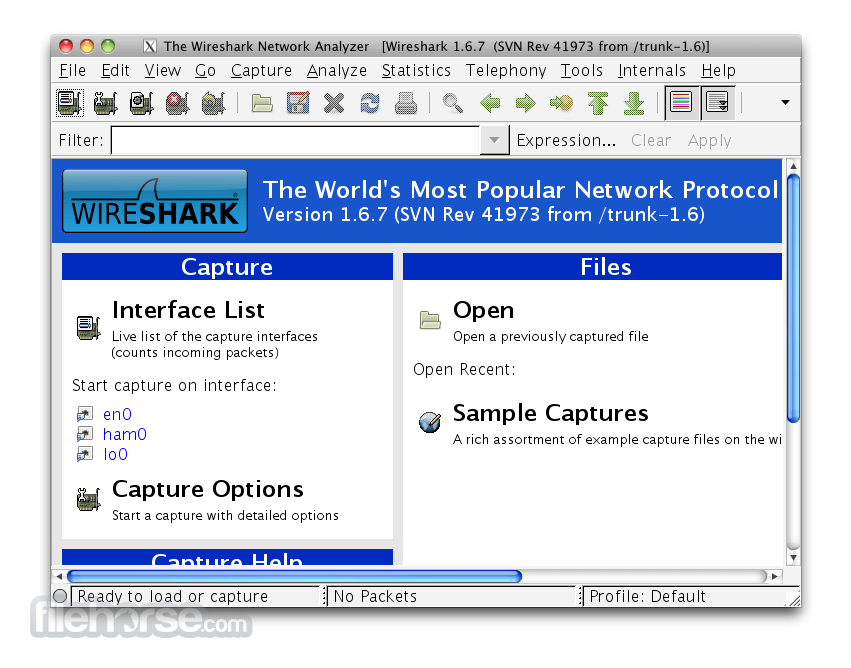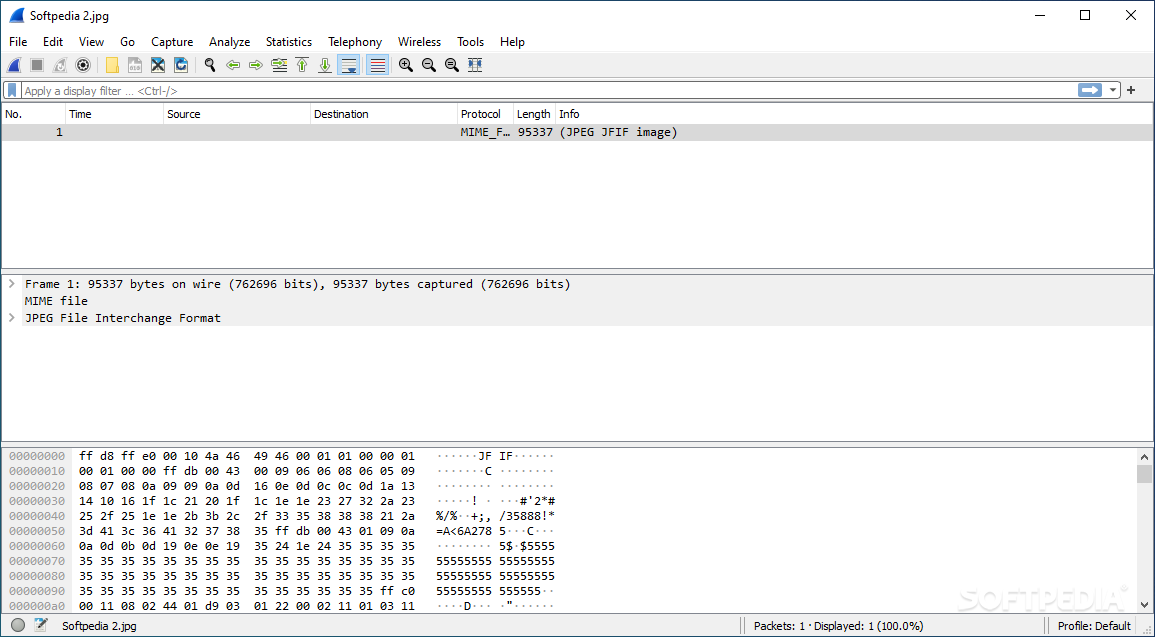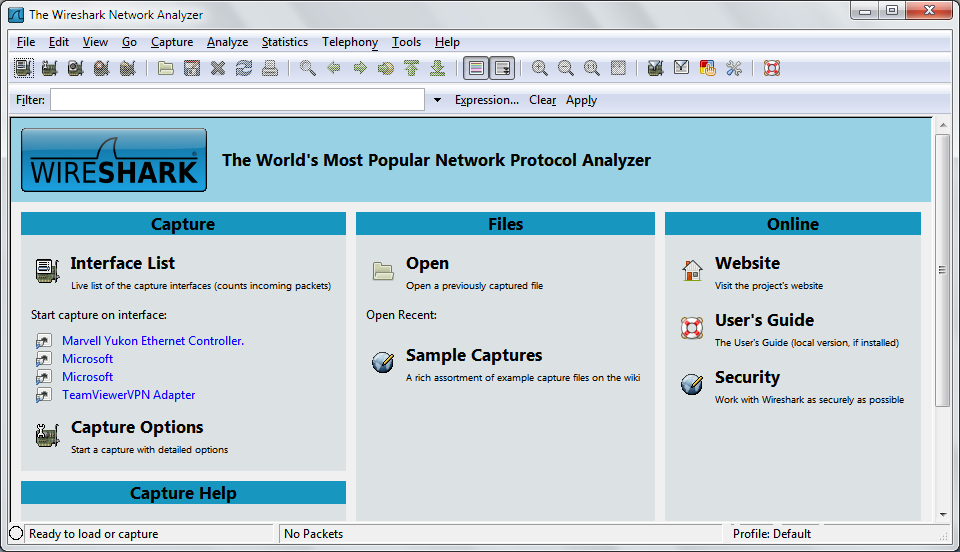This article will explain how to use wireshark to capture TCP/IPpackets. Specifically I will show how to capture encrypted (HTTPS)packets and attempt to document the 'dance' a client and server do tobuild an SSL tunnel.
What is Wireshark?
The Wireshark OUI lookup tool provides an easy way to look up OUIs and other MAC address prefixes. It uses the Wireshark manufacturer database, which is a list of OUIs and MAC addresses compiled from a number of sources. Type or paste in a list of OUIs, MAC addresses, or descriptions below. OUIs and MAC addresses may be colon-, hyphen-,. Wireshark 2.6 was the last release branch to support Mac OS X 10.6 and 10.7 and OS X 10.8 to 10.11. Wireshark 2.0 was the last release branch to support OS X on 32-bit Intel. Wireshark 1.8 was the last release branch to support Mac OS X on PowerPC.
Download Wireshark 3.4.8 for Mac. Fast downloads of the latest free software!
Wireshark is a network protocol analyzer for Windows, OSX, and Linux. Itlets you capture and interactively browse the traffic running on acomputer network. Similar software includes tcpdump on Linux.

Install Wireshark
First step, acquire Wireshark for your operating system.
Ubuntu Linux:sudo apt-get install wireshark
Windows or Mac OSX: search for wireshark and download the binary.
How to capture packets

This is Wireshark's main menu:
To start a capture, click the following icon:
A new dialog box should have appeared. Click start on your preferredinterface:
You are now capturing packets. The packet information is displayed inthe table below the main menu:
Now browse to an HTTPS website with your browser. I went tohttps://linkpeek.com and after the page completely loaded, I stopped theWireshark capture:
Depending on your network, you could have just captured MANY packets. Tolimit our view to only interesting packets you may apply a filter.Filter the captured packets by ssl and hit Apply:
Now we should be only looking at SSL packets.
Next we will analyze the SSL packets and answer a few questions

1. For each of the first 8 Ethernet frames, specify the source ofthe frame (client or server), determine the number of SSL records thatare included in the frame, and list the SSL record types that areincluded in the frame. Draw a timing diagram between client and server,with one arrow for each SSL record.
2. Each of the SSL records begins with the same three fields (withpossibly different values). One of these fields is “content type” andhas length of one byte. List all three fields and their lengths.
ClientHello Records
ServertHello Records
Wireshark Download Mac El Capitan
Looking for a better comment system?
You should try Remarkbox — a hosted comment service that embeds in your pages to keep the conversation in the same place as your content. It works everywhere, even static sites!Remarks: How to capture HTTPS SSL TLS packets with wireshark
Wireshark Labs
'Tell me and I forget. Show me and I remember. Involve me and I understand.'
Chinese proverb
One's understanding of network protocols can often be greatly deepened by 'seeing protocols in action' and by 'playing around with protocols' - observing the sequence of messages exchanges between two protocol entities, delving down into the details of protocol operation, and causing protocols to perform certain actions and then observing these actions and their consequences. This can be done in simulated scenarios or in a 'real' network environment such as the Internet. The Java applets in the textbook Web site take the first approach. In these Wireshark labs, we'll take the latter approach. You'll be running various network applications in different scenarios using a computer on your desk, at home, or in a lab. You'll observe the network protocols in your computer 'in action,' interacting and exchanging messages with protocol entities executing elsewhere in the Internet. Thus, you and your computer will be an integral part of these 'live' labs. You'll observe, and you'll learn, by doing.
The basic tool for observing the messages exchanged between executing protocol entities is called a packet sniffer. As the name suggests, a packet sniffer passively copies ('sniffs') messages being sent from and received by your computer; it will also display the contents of the various protocol fields of these captured messages. For these labs, we'll use the Wireshark packet sniffer. Wireshark is a free/shareware packet sniffer (a follow-on to the earlier Ethereal packet sniffer) that runs on Windows, Linux/Unix, and Mac computers. The Wireshark labs below will allow you to explore many of the Internet most important protocols.
We're making these Wireshark labs freely available to all (faculty, students, readers). They're available in both Word and PDF so you can add, modify, and delete content to suit your needs. They obviously represent a lot of work on our part. In return for use, we only ask the following:
Wireshark Download Mac Os
- If you use these labs (e.g., in a class) that you mention their source (after all, we'd like people to use our book!)
- If you post any labs on a www site, that you note that they are adapted from (or perhaps identical to) our labs, and note our copyright of this material.
The version 8.1 Wireshark labs have been significantly modernized and updated in 2021, and come with new Wireshark traces files taken in 2021. Click on the links below to download a Wireshark lab on the given topic.
How To Download Wireshark
| Lab topic | 8th ed. | 8th ed. | 7th ed. |
|---|---|---|---|
| Getting Started | 8.1 (Word) | 8.0 (PDF,Word) | 7.0 (PDF,Word) |
| HTTP | 8.1 (Word) | 8.0 (PDF, Word) | 7.0 (PDF, Word) |
| DNS | 8.1 (Word) | 8.0 (PDF, Word) | 7.01(PDF, Word) |
| TCP | 8.1 (Word) | 8.0 (PDF, Word) | 7.0 (PDF, Word) |
| UDP | 8.1 (Word) | 8.0 (PDF, Word) | 7.0 (PDF, Word) |
| IP | 8.1 (Word) | 8.0 (PDF, Word) | 7.0 (PDF, Word) |
| NAT | 8.1 (Word) | 8.0 (PDF, Word) | 7.0 (PDF, Word) |
| DHCP | 8.1 (Word) | 8.0 (PDF, Word) | 7.0 (PDF, Word) |
| ICMP | 8.0 (PDF, Word) | 7.0 (PDF, Word) | |
| Ethernet and ARP | 8.0 (PDF, Word) | 7.0 (PDF, Word) | |
| 802.11 WiFi | 8.0 (PDF, Word) | 7.0 (PDF, Word) | |
| SSL (currently being updated to TLS) | 8.0 (PDF, Word) | 7.0 (PDF, Word) | |
| Trace files(new trace files for 8.1; same trace files for 7, 8.0) | wireshark-traces-8.1.zip | wireshark-traces.zip | wireshark-traces.zip |
Wireshark Download Mac Os X
These Wireshark labs are copyright 2005-2021, J.F. Kurose, K.W. Ross, All Rights Reserved.
Last update to labs: June 4, 2020
Comments welcome: kurose@cs.umass.edu